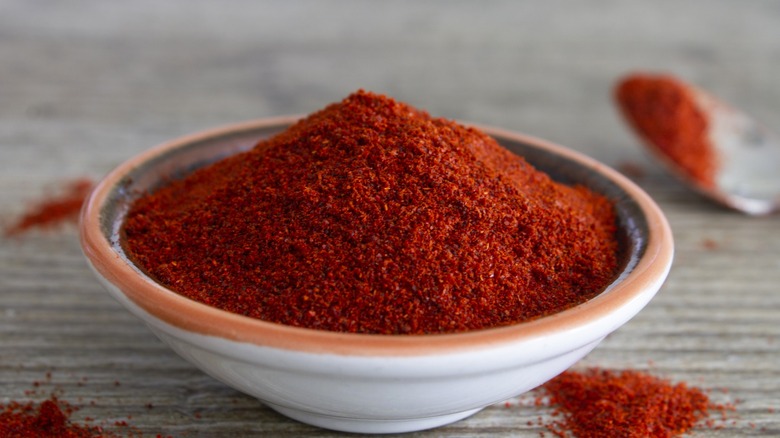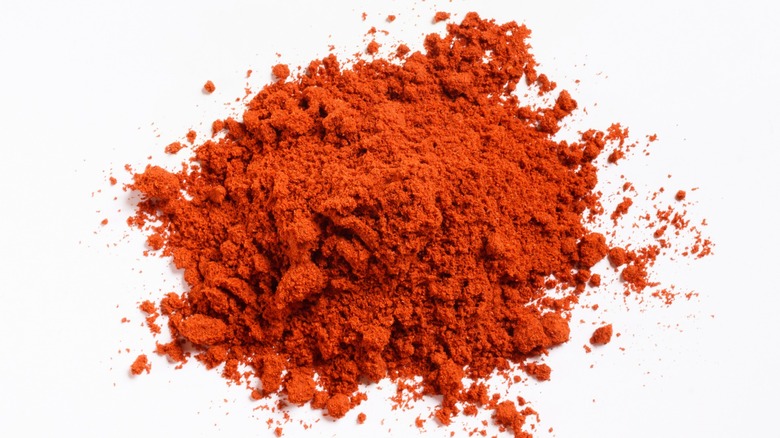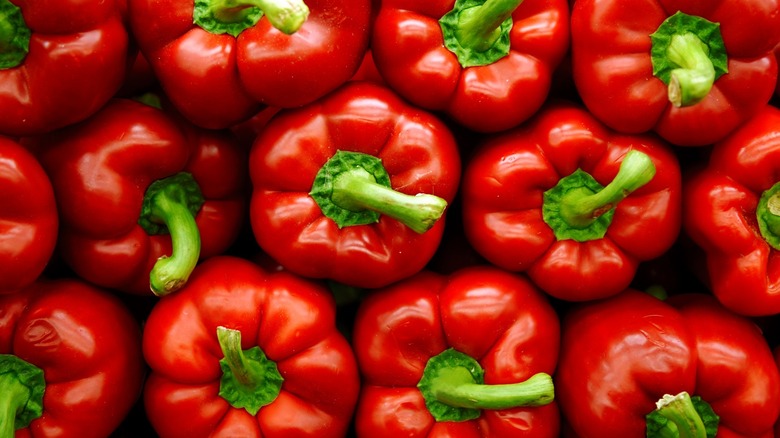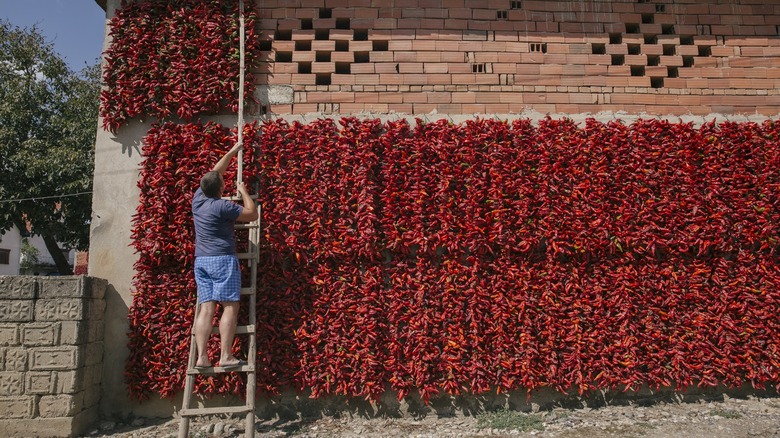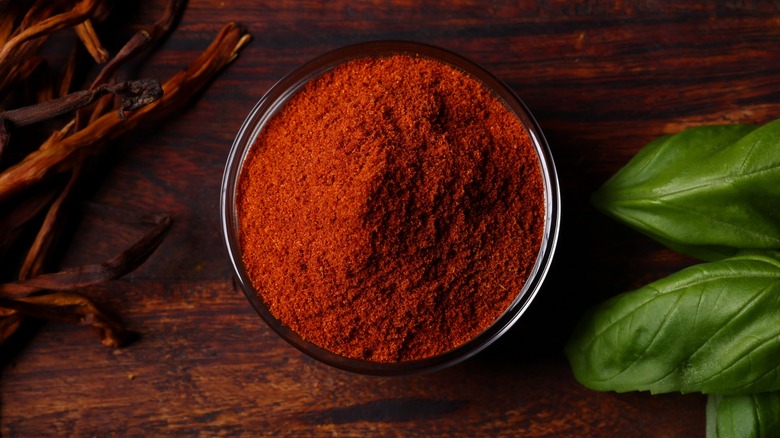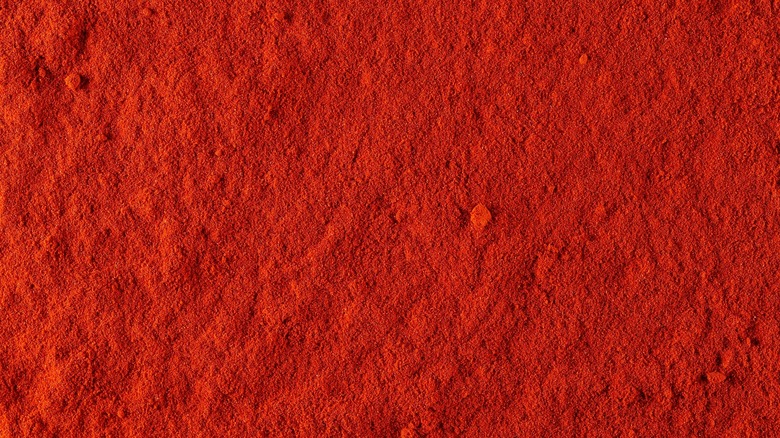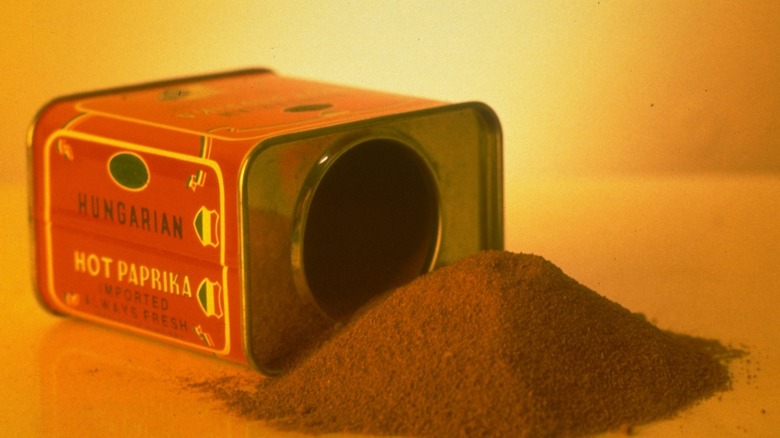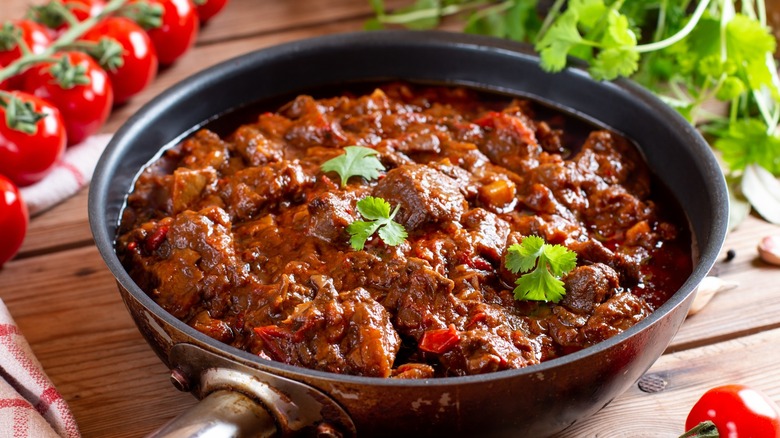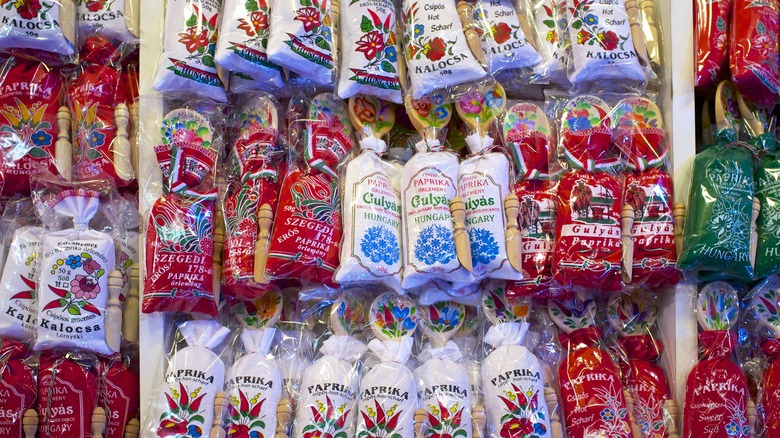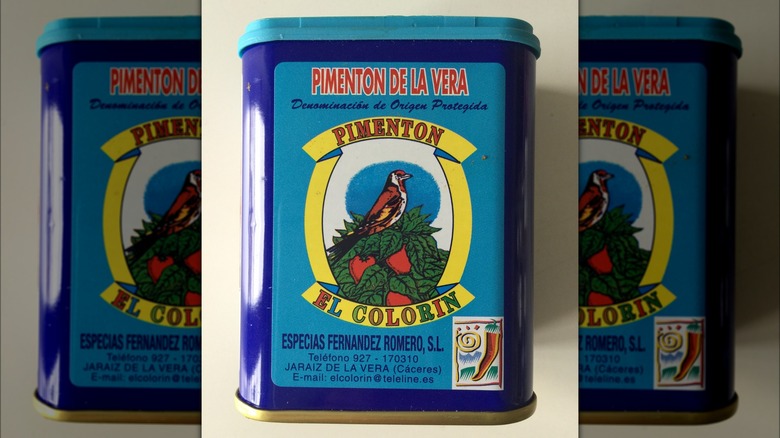What Is Paprika And How Is It Made?
We may receive a commission on purchases made from links.
Paprika is that bold red spice we all love. This versatile spice has a unique flavor that is a key component in many dishes worldwide. However, how many of us actually know what paprika is made from, where it originated, and how best to use it in our cooking?
In this article, we will take a closer look at paprika. We will also explore the many different varieties of paprika out there, in order to help you figure out which type of paprika to use, and when. By the time you finish reading this story, you'll know more about this rich, savory spice than you ever thought possible. You might even find yourself becoming the designated paprika expert among your friends and family!
There's so much to learn about paprika, so let's get started. From hot to smoked to sweet, it's time to dive deep into the world of paprika.
What is paprika?
First things first: It's pronounced "pa-pree-kah." Paprika is a deep crimson-colored spice that's made by drying sweet peppers from the Capsicum annuum family and grinding them into a powder. Unlike cayenne or chili powder, most paprika isn't usually very spicy, but there are various types of paprika out there. These varieties also range in flavor.
The name of this spice comes from the Hungarian word meaning "pepper," which refers to the vegetable. This stems from the Serbian and Croatian word "paprena," which means "the one that is hot." The origins of this word can be traced back to "papar," a different Croatian and Serbian word that also means "pepper." This word can be linked even further back, to the Latin word "piper." Again, this word means "pepper."
Etymology aside, the highest quality Hungarian paprika is generally labeled as "noble sweet," but you might need to head to a Hungarian store to find that. There's also Spanish paprika, which is often labeled as "pimentón." It's often milder and comes in several different varieties.
The history of paprika
Paprika may be popular in Hungary and Spain nowadays, but the spice has older roots in Central America, Southern Mexico, and the Antilles Islands (which are located in the Caribbean). In these places, Native Americans used paprika for seasoning, as it is used today. However, paprika was also widely used for its healing properties, thanks to the capsaicin found in peppers, which can help relieve pain.
Early Spanish explorers first brought the peppers for paprika to Europe. The pepper plants were initially used decoratively, in gardens belonging to nobility, so they were most known by wealthy people. Eventually, these peppers would be ground down to make paprika.
Paprika eventually made its way to Hungary. Though initially used as a cure for fever, it later became a key ingredient in Hungarian cooking and began to be used in traditional Hungarian dishes like goulash. Today, paprika comes in eight different varieties and is considered the country's national spice.
How is paprika made?
Sweet red bell peppers are dried and ground to make paprika. You can also make paprika at home by grinding dried peppers.
Smoked paprika is made by drying the peppers over smoking oak wood for 10 to 15 days. Over this period, the smoke and hot air dry out the peppers and impart a smoky flavor. Once dried, the peppers are ground into a fine powder.
Today, the spice's main production regions are Hungary, Spain, and South America, though it's also made in California. In Hungary, it's mostly made in the regions of Szeged and Kalocsa in the south of the country.
Jaraíz de la Vera, Spain is known as the Spanish capital of Paprika, due to the high-quality paprika that's made there. Paprika de la Vera — as paprika from the city is called — has a deep, smoky aroma that results from its drying process, in which it's smoked over holm oak. The town of Jaraíz de la Vera even has a paprika museum, which aims to teach the public about this spice, including its production method.
Paprika vs. cayenne vs. chili powder
It's easy to confuse cayenne, chili powder, and paprika, but it's pretty important not to do so! You can use paprika fairly liberally as it has a mild, smoky heat, sweetness, and vegetable taste — particularly if you buy high-quality smoked paprika. On the other hand, you'll want to limit how much cayenne or chili powder you use, unless you like your food extra spicy!
Ground red chili powder is often made with a mix of spices including cumin, garlic powder, salt, and paprika, and has an earthy, spicy flavor. Cayenne is hot, hot, hot! It's made from dried, ground moderately hot chili peppers and has a fiery flavor that's used to add heat in a variety of dishes. It also packs a grittier texture and more orange color than the deep crimson of paprika. We don't recommend you substitute cayenne or chili powder for paprika, as their flavor profiles are too different.
What does paprika taste like?
Compared to spices such as cayenne and chili powder, paprika is lower in capsaicin, the compound in red pepper responsible for its heat — which makes it less hot than these other spices. Its sweetness also comes from the fact it contains quite a lot of sugar — up to 6%. Most basic paprika you'll find in grocery stores also has a vegetal flavor — one that tastes more like actual red pepper. This flavor comes from compounds known as methoxypyrazines.
As we already mentioned, some paprikas can be smoky, while others pack blistering heat. Generally speaking, Spanish paprika is milder and more smoky, while some Hungarian varieties are hot. Smoked paprika has a rich, wood-like flavor. Smoky notes can vary, depending on what type of wood is used for smoking and how long the peppers are smoked for.
If you're new to using paprika in your cooking, basic or Spanish paprika are generally safer choices than Hungarian. But we'd recommend keeping both sweet and smoked paprika on hand, as they have different uses.
Comparing Hungarian and Spanish paprika varieties
Generally speaking, there's sweet, smoked, and hot paprika. But dig deeper — or visit a Hungarian store or Spanish deli — and you'll uncover more! Spicy Hungarian paprika is sweeter, as a cooler climate ensures the peppers retain natural sugars, whereas Spanish paprika has more of a smoky flavor.
There are eight main types of Hungarian paprika. Special Quality paprika is the mildest Hungarian paprika and boasts the brightest crimson color. Then, there are three Delicate varieties: Delicate, which is mild but rich in flavor, and can range in color from a light red to a darker hue; Exquisite Delicate, which has a slightly stronger taste and smell than Delicate; and Pungent Exquisite Delicate, the most pungent of the three. Noble Sweet paprika is considered to be the finest Hungarian paprika available worldwide. It has a bright red color. Rose paprika has a paler red hue with a very strong smell but mild flavor. Half-Sweet paprika has a medium-strong flavor and is a blend of paprikas. Hot paprika is likely to scorch your tastebuds. Rather than being red, it's light brown.
How about Spanish paprika? Paprika in Spain is mostly made in La Vera and Murcia. You'll find two main types: Pimentón de la Vera (smoked Spanish paprika). It comes in spicy, sweet, and bittersweet varieties. And Pimentón De Murcia (Sweet Spanish paprika). In most stores, you'll also find basic paprika. It usually has a mild flavor.
How to cook with paprika
Use paprika in your cooking not only for its vivid red color but also for its mellow flavor. Thanks to its mild flavor, you can use it liberally in almost any dish you like — unless you bought the hot stuff! It's the perfect way to add color to lighter foods like deviled eggs, potato salad, or rice.
Of course, paprika is a must for Spanish and Hungarian dishes, from paella to goulash. Why not add it to your Hungarian chicken paprikash, or use sweet or smoked paprika in your Spanish patatas bravas? Paprika is also a great addition to spice rubs for all your favorite meats. Just mix it with salt, black pepper, thyme — or any other spices you like — to add color and flavor. Smoked paprika can even be used to add flavor to Cajun shrimp and grits.
Did you know that paprika's vibrant crimson hue and flavor are affected by heat? Add it towards the end of cooking where possible, and try to use low heat with dishes containing paprika — its high sugar content means it can burn quickly.
Where to buy paprika
Basic paprika is found in most grocery stores in the spice aisle. You'll usually find smoked paprika there too. In some larger stores, you may find Spanish pimentón or Hungarian paprika. However, if you want the most authentic, highest-quality paprika, we'd recommend going to stores specializing in Hungarian or Spanish foods.
If you're in the United States, Spanish food stores may stock La Vera Spanish paprikas. These are always sold in colorful tins, which helps them to stay fresh for longer. Make sure you check the expiration date, too, as the flavor of these paprikas will diminish over time.
Can't find paprika in your neighborhood? Online spice stores like Amazon are a good bet, where you can find hot and sweet La vera paprika varieties. Chef-recommended brands to look out for in your local store include Pimentón de La Vera, Chiquilín, and La Chinata. If you don't want to buy paprika, you could always make your own!
How to store paprika
It's always best to buy paprika in a tin, rather than a glass jar so that light and heat don't degrade the color and flavor of the spice. Most high-quality Hungarian and Spanish paprika already come in a colorful tin, but you should also make sure that you keep the tin in a cool, dark place such as a cool pantry, spice drawer, or refrigerator. Don't store the paprika next to your stove!
Basic paprika often comes in a glass jar, but can easily be decanted into a tin or another airtight container for storing. Make sure to check the expiration date before purchasing, as paprika will lose its flavor and color over time. Keeping it in a tin should help it last longer, but for best results, we'd recommend using it within six months of purchase. It's such a versatile spice and can be added to so many dishes that using it all up shouldn't be a problem.
The health benefits of paprika
Turns out, paprika isn't just tasty and colorful, it also has health benefits, too! In 1937, Albert Szent-György, a Hungarian chemist, carried out research into paprika's vitamin content and later won the Nobel Prize for his work. His research revealed that paprika contains more vitamin C than citrus fruit! That's a very good reason to add this vivid red spice to your food.
The capsaicin found in peppers is also packed with antioxidants that have a variety of health benefits, helping to improve immunity, relieve gas, and even reduce your risk of cancer and heart disease. Capsaicin may also help with weight loss and could protect your skin from damaging UV rays.
Finally, paprika is a good source of several vitamins and minerals, including vitamins A, E, K, and B-6. It also contains plenty of folate, for healthy cell growth and function, niacin, which can boost your levels of good HDL cholesterol, and choline, for a healthy brain and nervous system.
